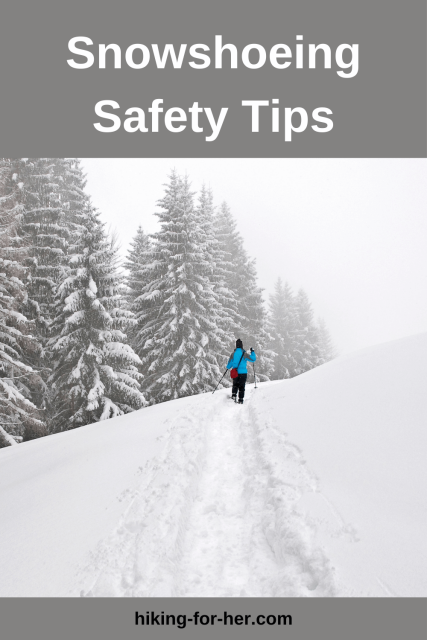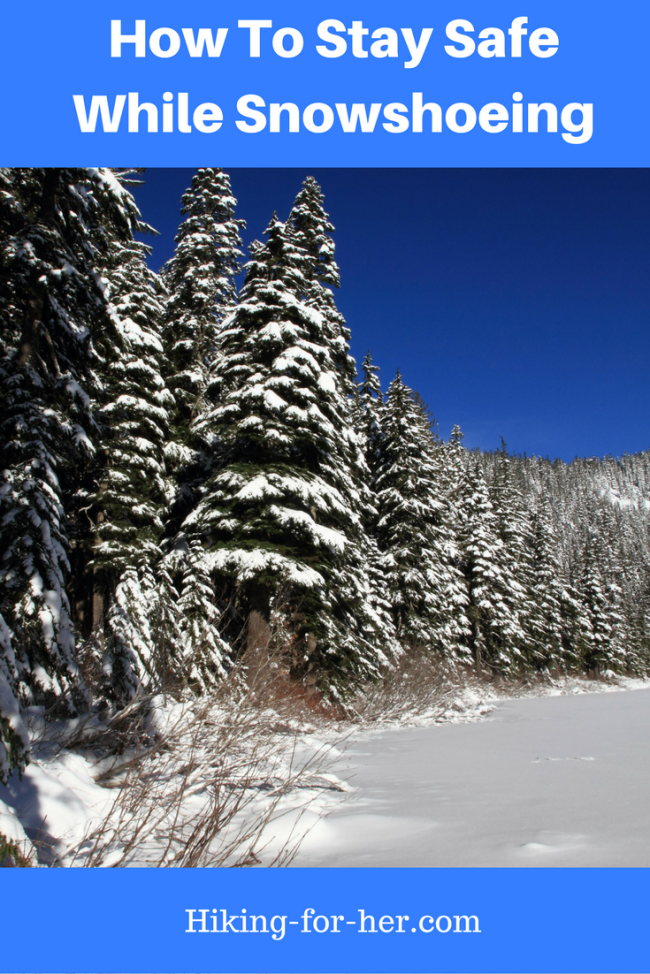
Best Snowshoeing Safety Tips
For Smart Winter Adventurers
By Diane Spicer
Snowshoeing safety tips + the right snowshoeing gear means you can get onto that lovely coldness and make some footprints while avoiding trouble.
But before you head out to play, it's important to know a few mental tricks about safe winter hiking.
Snowshoeing safety: way different than summer hiking
Let's spell it out.
Snowshoeing is winter hiking.
Simple enough.
But not really.
It's a bit different than following a summer trail, for one thing. The days are shorter. The weather is more unpredictable. The gear you carry differs, too.
So your approach to snowshoeing safety needs to be much different. And your hiking skill set needs to expand if you're expanding into snowshoeing.
What to pay attention to as a smart and safe snowshoer
Snowshoeing safety involves these factors:
- advance planning of a suitable, safe route
- common sense in the face of unexpected challenges
- proper gear and food to stay warm and dry
- a constant eye on the weather
- physical conditioning for the rigors of snow travel
- survival skills should something go wrong
- lack of ego
Let's clear up that last factor first.
Big ego, big trouble for snowshoers!
Ego gets hikers, including winter hikers called snowshoers, into trouble faster than many other things.
Big ego, potential for big trouble.
And moreso in winter hiking, given the smaller margin for error: shorter daylight hours, temperature extremes, route finding challenges, not enough fuel (food).
Ego shows up as stubbornness, blindly clinging to opinions, overtalking others while making decisions, and inflexibility in the face of changing conditions.
Here's an example to ponder
A snowshoer with a big ego:
- Doesn't want to "waste" the day by turning back when the weather starts turning.
- Stubbornness masquerades as "steely resolve".
- Guessing about what's ahead on the terrain, or about the safety of crossing steep slopes.
- Is exhausted, but too proud to slow down or modify pace.
If you're snowshoeing with someone like that, you have to keep an eye on yourself to know when you've reached your limits.
Ask yourself: are you:
- Too shy/embarrassed to admit to your snowshoeing buddies that you're tired out and need to rest?
- Starting to really feel the cold in your fingers and face?
- In over your head but don't want to "ruin" the trip for others?
Hmmm ... think about it
Your pride, versus your life.
Speaking up, versus swallowing your truth.
Going with the "sunk cost fallacy" of "we've come this far...".
Should you be snowshoeing with folks you don't trust? Or can't be honest with?
Are you really "wasting" the day if you turn back, or are you learning that you need to be more prepared next time?
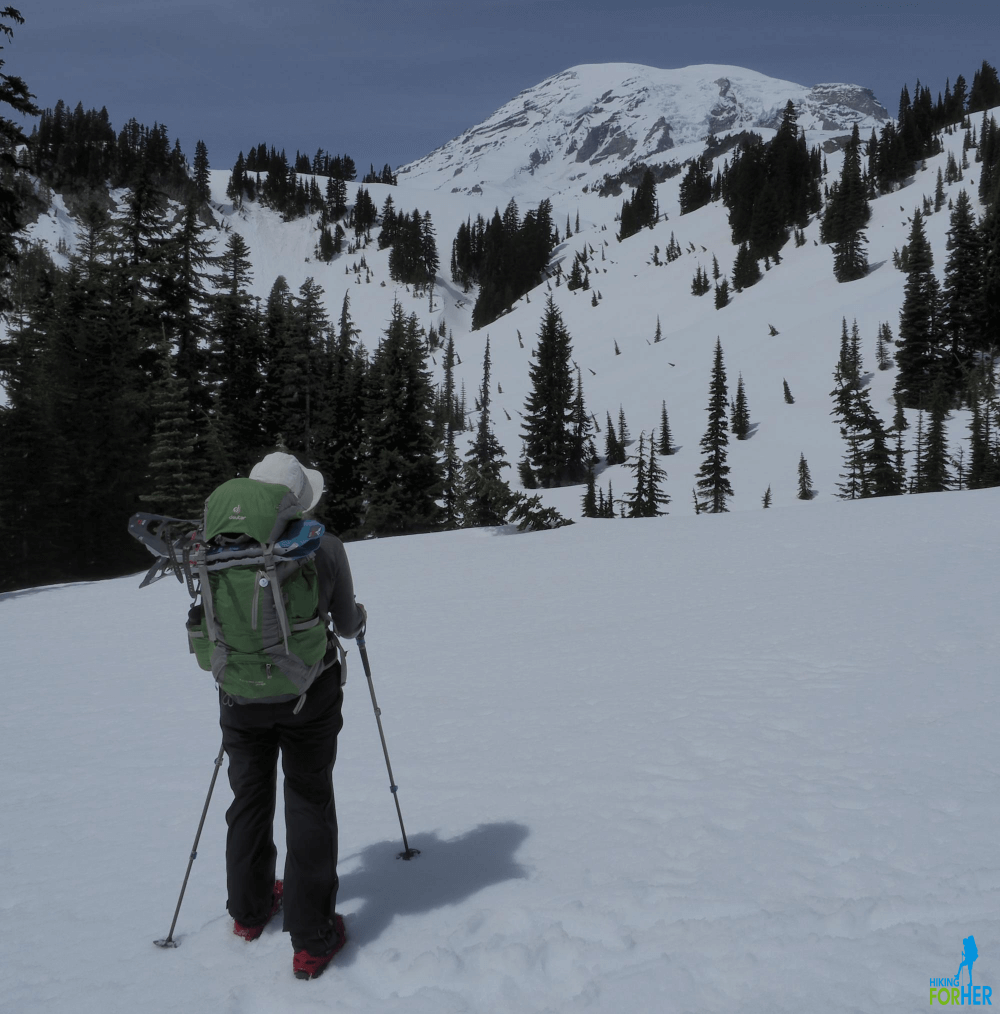 Sometimes you'll carry your snowshoes if snow conditions change
Sometimes you'll carry your snowshoes if snow conditions change
It's all in how you spin it
It's all in how you spin it - to yourself.
Every human body has it limitations, and when you're tired and cold, game over!
- Cover up all exposed areas with dry gloves, hat, neck gaiter, and balaclava.
- Eat a snack. Then eat another one.
- Sip a hot drink that you carry in an insulated container like this one.
- Or prepare one quickly, right there on the trail with a JetBoil.
- If you have to sit down, first put down an insulated layer, or perch on top of your backpack.
Then head back to the trail head, guilt free and safe.
Consider these safety factors
Now let's get back to that list of snowshoeing safety factors.
Advance planning involves doing your homework.
Research the availability of marked trails or routes, or pour over topographical maps to get a bird's eye view of where you're headed.
Build a mental map of the terrain.
Why?
To be prepared for water crossings, avalanche hazards, exposed wind swept areas that may be icy, or densely forested patches where you might lose the trail.
Don't just blindly strap on your snowshoes and head off, even if you're with a group or relying on someone who's been there before.
- Know what's in front of you.
- Know how far you intend to travel.
- Set a turn around time, with due consideration for early nightfall in winter months or bad weather conditions.
Bottom line for safety as a snowshoer:
Snowshoeing safety rests upon knowing the way into the area, and out again, even when the weather goes sour in the short hours of winter daylight.
Make it a solid habit to check the weather conditions before you head out on your adventure to avoid nasty surprises.
And keep aware of what the wind is doing and what the clouds are telling you.
Use your sixth sense!
Common sense simply means listen to your gut.
Or maybe I should use the more "feminine" word: intuition.
Every woman knows when her internal alarm goes off.
You may get a twinge in your gut (solar plexus area), warning you that something doesn't feel right.
Some women report tingling or pins & needles sensations up their backbone.
The word "uh-oh" may even flash through your mind.
If something seems "off", it probably is.
Honor that wisdom.
Stop in your tracks and survey your surroundings.
Then take a mental inventory:
- Did you hear something that alerts you to potential danger? (falling snow, a cracking sound)
- See something unusual out of the corner of your eye? (movement, a change in color)
- Is there a new odor (animal cache signaling a cougar in the area)?
Gather as much data as you can about what has changed, and then react on the basis of facts.
Gear up for snowshoeing success
Proper gear for snowshoeing adventures will vary, which is no surprise, right?
Your snowshoes depend on the type of sun, snow, terrain and wind conditions you're facing.
For example:
- In the Pacific Northwest, on the west slopes of the Cascade Mountains, snow is heavy and wet.
- Drive up and over the crest of the Cascades via Stevens Pass or Snoqualmie Pass, and the snow becomes dry & powdery.
This requires a snowshoer to wear & carry the right snowshoes as well as versatile snowshoeing gear.
Waterproof outer layers are a must.
Regardless of the conditions you'll face, frostbite prevention is common to all snowshoeing endeavors, so layer up like you mean it!
And keep your feet warm with these tips.
Oops! Don't skip these warm hands tips.
And these general tips for hiking in cold weather.
Eat and drink well on your snowshoe hike
Long story short, eat often and brink something hot to drink.
These snowshoeing food best tips will get you started.
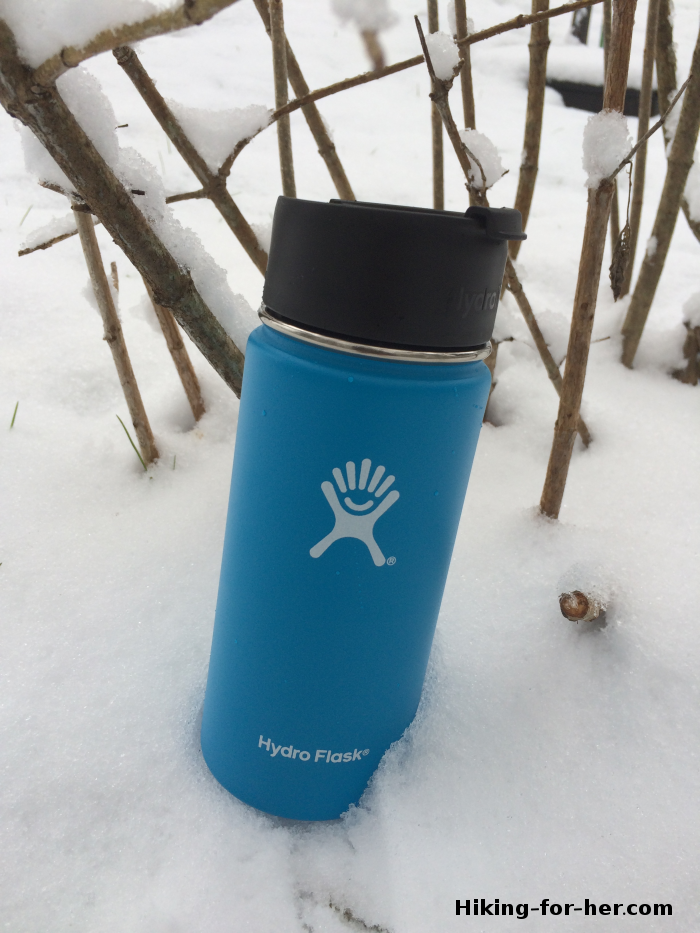 A hot beverage goes a long way toward comfort on a snowshoe hike
A hot beverage goes a long way toward comfort on a snowshoe hike
Conditioning tips for snowshoeing
Physical conditioning can be a pain in the rear - but that's exactly what it prevents.
Snowshoeing calls upon your hip and thigh muscles in ways that dirt trails won't.
You might have to tweak your usual work out routine as you prepare for the winter season.
- Extra stair climbing, more cross training, special attention to leg muscles with squats... whatever it takes, right?
You don't want to run out of muscle power when you're facing cold, windy miles to get back to your car.
Another way to stay in shape, keep your flexibility and enhance your balance is with yoga for hikers.
More tips on pre-hike conditioning
Survival knowledge for snowshoers
Snowshoeing safety depends heavily upon survival skills:
- how to avoid or reverse
hypothermia
- how to avoid hazards such as becoming trapped in tree wells or becoming swept away by an avalanche
You can never have too many snowshoeing safety skills, especially in bitterly cold weather or stormy conditions.
So here are a few more for your reading pleasure:
- These cold weather hiking tips are "must know" information.
- Put together a survival kit, using these tips.
- More snowshoeing safety tips
Don't let this happen to you!
Please don't make the mistake of packing light because you'll "only be gone a few hours".
Recently, I had a great "refresher" lesson from Mother Nature on the importance of advance planning for snowshoeing safety.
I was several miles from home base, on a bitterly cold and windy day.
I hadn't planned on staying out long.
While stepping up onto a snow bank after crossing a frozen stream, my snowshoe punched through an air space in the bank.
- I fell forward, lodging my snowshoe deeply into the snow.
- I was stuck! Like, seriously not moving.
- Plus I was standing on slippery ice with one leg, while the other leg was off balance.
- And I had snow all over my face, neck and arms, down my neck, inside the cuffs of my jacket.
Luckily, I was somewhat sheltered from the wind.
And I was able to wiggle myself into a space where I could remove the other snowshoe and use it to dig myself out.
But if I had not been able to move, the good news was that I had warm clothes, food, and a thermal blanket like this one in my pack to keep me safe until help arrived.
So there was no need to panic, only react calmly.
I was also carrying a satellite communication device.
The bad news?
In the process of digging, I jammed cold, wet snow deeper into my clothes, and my gloves were soaked.
That's really bad news, especially when the wind is blowing hard.
Extra clothing to the rescue!
- Read about why you should carry the Ten Essentials.
- And promise me you'll carry them year round, but especially for winter hiking, when they matter the most!
Go snowshoeing, but go prepared
Snowshoeing is a great sport, you just have to give it the respect and careful planning which it deserves.
You might make a few new friends, too...
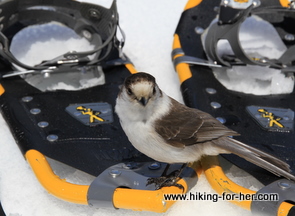
Questions about snow shoeing?
Try more in depth snowshoeing tips to dig into the answers for safe snowshoeing:
- 8 Reasons To Try Snowshoeing
- How To Buy Snowshoes
- How To Buy Winter Boots
- Snowshoeing Gear
- Washington State Snowshoeing Destinations
- REI Co-op Snowshoeing Outings
Save these to your Pinterest wintering hiking and snowshoeing boards!
Snowshoeing Safety
|
I get emails all the time about what I wear, eat, carry and love to use on the trail. That's
why I provide affiliate links to you: the best gear that I use myself and have seen used by other hikers is instantly
available for your consideration, and the gear company sends a few
pennies per dollar to this reader-supported hiking website. There is no added cost to you! Everyone ends up a winner: Great gear for you, strong gear companies, and more free hiking tips for everyone. Thanks very much for your support. It's warmly and sincerely appreciated. It also helps send these hiking tips to all your virtual trail buddies around the globe. |
 |
